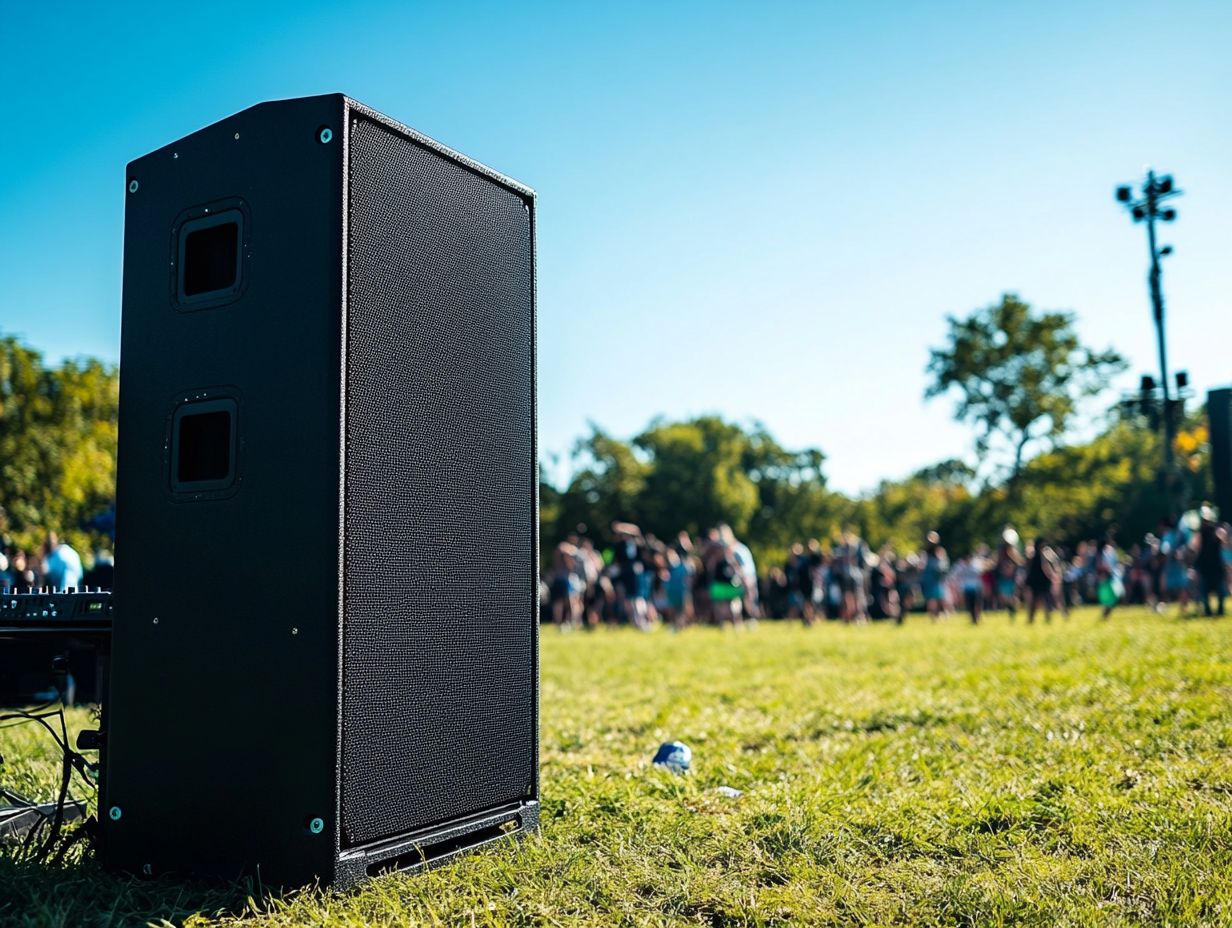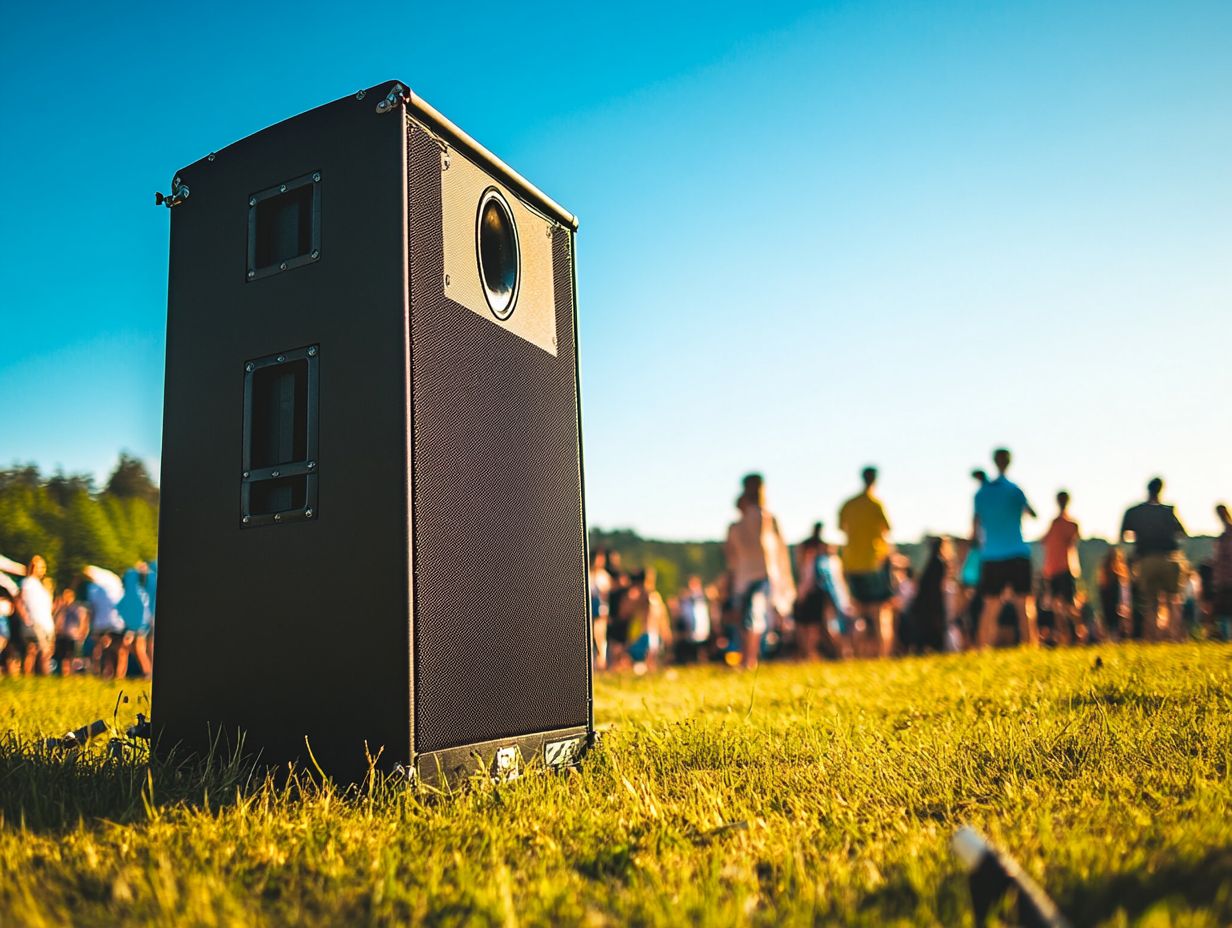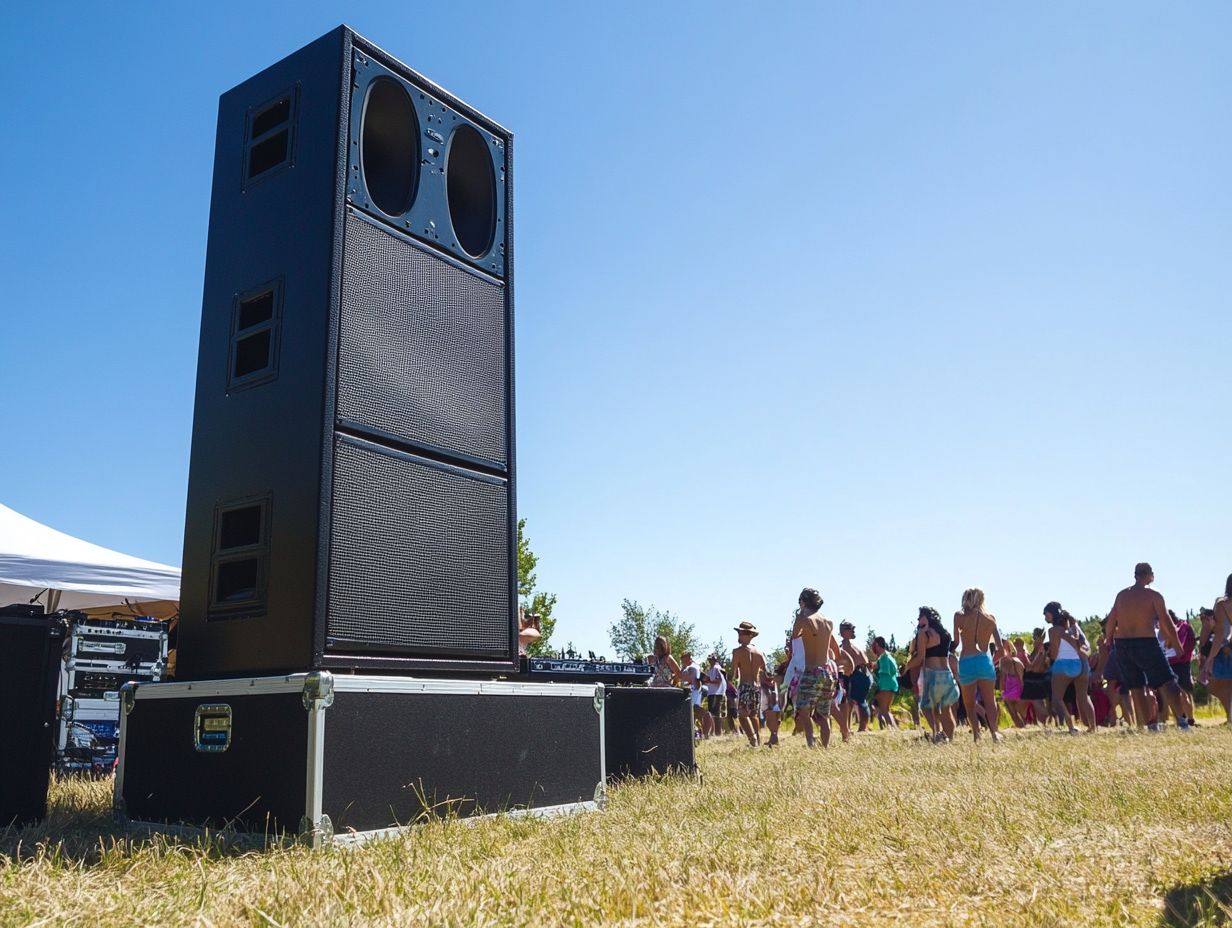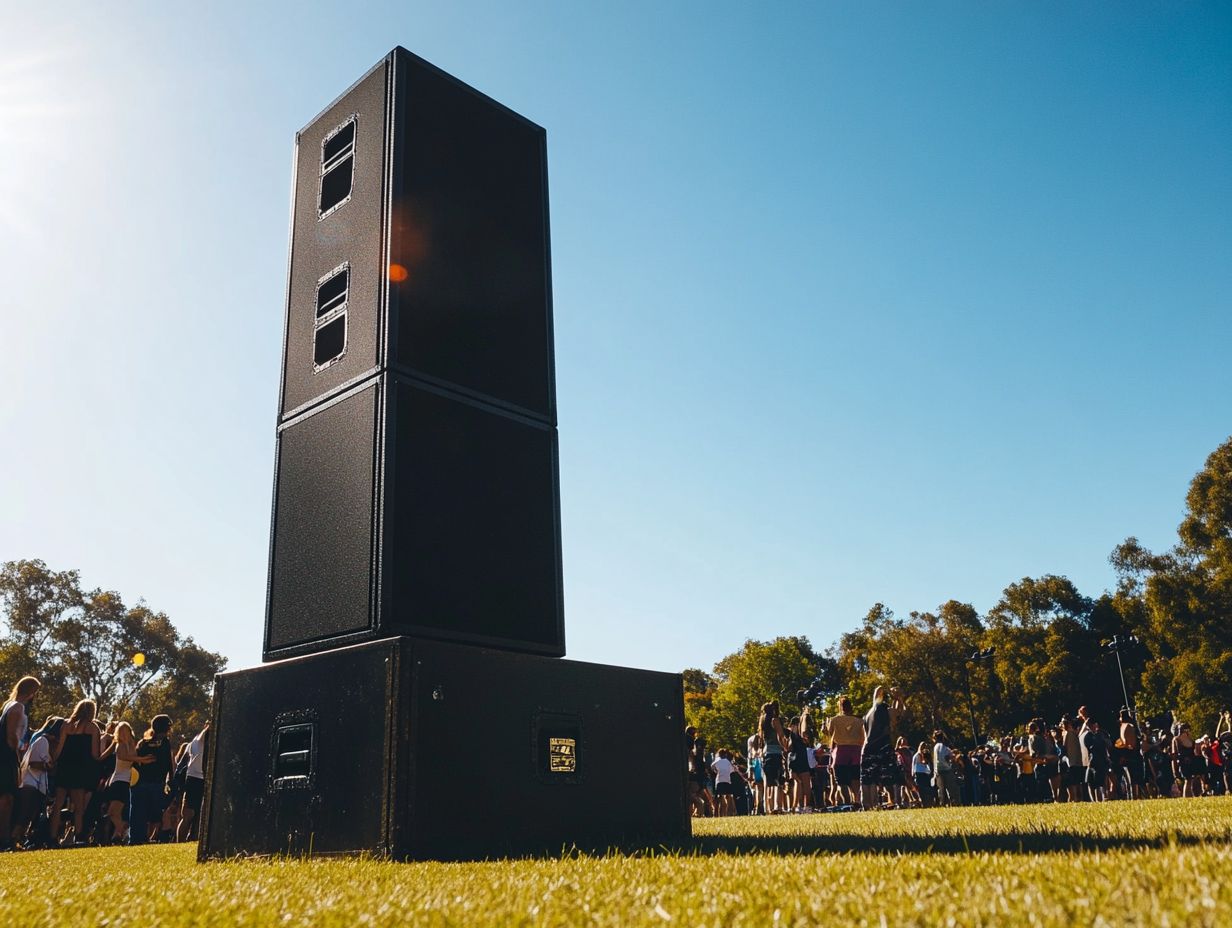When it comes to enjoying music or sound in outdoor settings, a quality subwoofer is crucial for delivering the deep bass and powerful sound that create an immersive experience.
Whether you’re hosting a backyard party, setting up for a community event, or simply enjoying a day at the park, the right outdoor subwoofer can transform your audio experience.
This guide will help you navigate essential factors to consider, recommend top models across various price ranges, and share tips for optimal installation and setup.
Dive in to discover how to elevate your outdoor sound with the best field subwoofers available!
Why a Subwoofer is Essential for Outdoor Sound

A subwoofer is a crucial component for outdoor sound systems, as it significantly enhances bass response, which is essential for providing a comprehensive auditory experience when listening to various music genres in open environments. Without the deep, resonating tones produced by a high-quality subwoofer, outdoor music listening can feel flat and lack the richness needed to adequately fill larger spaces such as backyards or patios.
The dynamic capabilities of a subwoofer ensure effective sound wave propagation, maintaining audio clarity and balance across extended listening distances, even amidst environmental noise.
This enhancement is particularly important in outdoor settings, where sound can easily dissipate. The design of different subwoofers, such as ported versus sealed enclosures, plays a significant role in their performance outdoors. For example, ported subwoofers often deliver more powerful bass at lower frequencies, making them well-suited for vibrant music styles like hip-hop, while sealed subwoofers offer more precise and tighter sound, making them ideal for genres such as classical or acoustic.
Integrating subwoofers with high-quality audio systems, including amplifiers and speakers specifically designed for outdoor use, further optimizes the listening experience. By ensuring compatibility and strategic placement, one can achieve a balanced soundscape that enhances the enjoyment of the outdoor ambiance for all attendees.
Key Factors to Consider When Choosing an Outdoor Subwoofer
When selecting an outdoor subwoofer, it is essential to consider several critical factors to ensure optimal sound quality and durability in various weather conditions. Key considerations include the subwoofer’s weather-resistant design, which is vital for withstanding environmental elements, and its compatibility with an audio receiver or existing speaker system.
The installation process should be user-friendly, facilitating seamless integration into an outdoor audio setup while taking into account the desired bass response and overall speaker performance tailored for open spaces.
The overall power output of the subwoofer is significant in achieving the desired volume levels without distortion, thereby enhancing the immersive listening experience. It is advisable to seek models that exhibit robust construction and protective enclosures to improve durability and ensure resilience against rain, sun, and other outdoor elements.
Additionally, evaluating the frequency range can provide valuable insights into the clarity of sound reproduction, which is particularly crucial for expansive outdoor environments. Lastly, ease of maintenance should not be overlooked; convenient access to components for servicing can significantly extend the lifespan of the subwoofer.
Top Recommendations
Selecting the optimal outdoor subwoofer involves navigating a diverse market that provides a variety of options tailored to different needs and budget constraints. This ensures that consumers can identify a suitable model that aligns with their audio requirements.
The range includes the best overall outdoor subwoofers, which are engineered for exceptional sound performance, as well as budget-friendly alternatives that still offer commendable bass response. For audiophiles seeking advanced features, there are high-end models available.
Furthermore, portable outdoor subwoofers present an ideal solution for individuals desiring flexibility in their outdoor audio arrangements.
Best Overall Outdoor Subwoofer
The OSD Audio AP650 is recognized as the premier outdoor subwoofer, offering exceptional sound quality and performance tailored for outdoor environments. Constructed with a robust, weather-resistant enclosure, this subwoofer guarantees consistent audio playback across diverse outdoor conditions, making it an excellent choice for music enjoyment on patios or during social gatherings. Its powerful bass response enhances a wide range of audio products, delivering an immersive listening experience while maintaining sound balance and clarity, regardless of listening distance.
This subwoofer features 6.5-inch polypropylene cones and a high-quality built-in amplifier, which significantly enhance its capabilities, ensuring deep, rich bass that can effectively fill larger spaces without distortion. Users will find the installation process to be straightforward, as it can be seamlessly integrated with existing audio systems utilizing standard speaker wire connections.
Listening tests demonstrate that the AP650 performs exceptionally well in outdoor settings, providing clear sound reproduction even at elevated volumes. Its versatile design allows for multiple mounting options, making it a flexible addition to any outdoor audio setup. Ultimately, the combination of durability, ease of installation, and superior acoustic performance cements its status as the preferred choice for outdoor sound enthusiasts.
Best Budget Outdoor Subwoofer
For individuals seeking an affordable solution that does not compromise on performance, the Dayton Audio IO8XTB stands out as the premier budget outdoor subwoofer, offering exceptional value for its price. This model is designed with durability in mind, allowing it to withstand outdoor conditions while delivering remarkable sound quality and bass response.
Its straightforward installation process and compatibility with various outdoor speaker connections make it an ideal choice for enhancing audio experiences without incurring significant costs.
Equipped with weather-resistant components, users can have confidence that their investment is safeguarded against the elements, thus ensuring both longevity and reliability. The speaker provides clarity and depth, facilitating crystal-clear highs and rich lows, which makes it suitable for both social gatherings and tranquil evenings spent outdoors.
Additionally, its lightweight design allows for easy mounting and placement, while still delivering powerful performance typically associated with higher-end models. This subwoofer effectively balances affordability with superior sound characteristics, catering to both audiophiles and casual listeners who seek an improved outdoor audio experience.
Best High-End Outdoor Subwoofer
For audiophiles, the ideal high-end outdoor subwoofer seamlessly integrates exceptional audio performance with superior build quality. A notable example is the Victrola Rock Speaker Connect, which provides remarkable sound quality and deep bass response.
Engineered for discerning listeners, this high-end subwoofer complements sophisticated audio receivers and enhances outdoor audio systems. Its weather-resistant features ensure durability, making it an excellent long-term investment for outdoor sound quality.
With a visually appealing rock design, it blends effortlessly into garden landscapes while delivering an enhanced listening experience. The Victrola Rock Speaker Connect is equipped with advanced technology that allows for easy connectivity to multiple devices, ensuring uninterrupted enjoyment of favorite music.
Its superior sound staging and clarity elevate outdoor gatherings, creating memorable experiences. This model not only distinguishes itself through robust performance but also fosters the immersive atmosphere that audiophiles seek.
Furthermore, the product is backed by reliable customer support, reflecting a commitment to excellence in providing high-quality outdoor audio experiences.
Best Portable Outdoor Subwoofer

The OSD Audio BTR805 is a highly recommended option for individuals seeking a premier portable outdoor subwoofer, providing exceptional convenience and sound quality within a compact design. This model enables users to easily transport their audio system from one location to another, making it ideal for outdoor events or gatherings.
Despite its portability, the BTR805 maintains impressive performance, delivering robust bass response and compatibility with a wide range of Bluetooth speakers and other audio devices.
A notable feature of the BTR805 is its user-friendly installation process, which requires minimal setup time—perfect for spontaneous outdoor gatherings or barbecues. Its lightweight and compact structure ensures that transporting it, whether for a picnic in the park or a beach party, is convenient and effortless.
This subwoofer is also built to be highly durable, designed to withstand various environmental conditions, thus ensuring quality sound even in less than ideal settings.
Ultimately, it embodies the essence of contemporary outdoor sound systems, merging portability, superior sound fidelity, and ease of use, making it an essential companion for any outdoor enthusiast.
Performance Features
When evaluating outdoor subwoofers, the performance features are critical in determining their overall effectiveness and suitability for outdoor environments.
Key features to consider include:
- Sound quality, which encompasses both clarity and richness of audio;
- Bass response, which is essential for delivering impactful low frequencies;
- Durability, which ensures that the subwoofer can withstand various weather conditions.
Furthermore, assessing weather resistance is crucial for long-term performance, as it protects the subwoofer from moisture, dust, and other environmental factors.
Sound Quality and Bass Response
Sound quality and bass response are essential elements of any outdoor audio experience, as they significantly affect how music is perceived in open environments characterized by ambient noise. A high-quality outdoor subwoofer must deliver clear audio with a comprehensive sound range that enhances the listening experience across various music genres.
In particular, the bass response should be sufficiently powerful to penetrate outdoor elements, ensuring that deep low frequencies are felt even amidst competing sounds from nature or crowd chatter.
The selection of subwoofer technology is crucial for achieving optimal audio clarity under diverse listening conditions. For example, ported subwoofers typically offer greater efficiency and deeper bass, while sealed models provide enhanced precision and tighter sound reproduction.
Understanding the nuances of each type enables enthusiasts to make informed decisions and customize their setups for optimal performance, whether at a picnic, during a camping trip, or at a backyard gathering. Ultimately, prioritizing sound quality and robust bass not only enhances outdoor enjoyment but also transforms the listening experience into an immersive journey through music.
Durability and Weather Resistance
Durability and weather resistance are critical considerations for outdoor audio devices, particularly subwoofers, which frequently encounter challenging environmental conditions. A robust design with a high Ingress Protection (IP) rating, such as IPX6 or IP54, ensures that the subwoofer can endure exposure to rain, dust, and other elements without compromising sound quality. This protective design not only prolongs the lifespan of the subwoofer but also preserves its performance, enabling consistent audio enjoyment across various outdoor settings.
To achieve optimal outdoor audio quality, these subwoofers utilize materials specifically engineered to resist corrosion and prevent fading due to UV exposure, thereby enhancing their longevity. Additionally, features such as reinforced enclosures and weatherproof connectors play an essential role in safeguarding the internal components, ensuring that the sound produced remains rich and powerful, regardless of weather conditions.
Investing in outdoor subwoofers that emphasize these protective attributes allows audio enthusiasts to relish their favorite music during outdoor events or gatherings without concern for sudden climate changes that could cause damage or diminish performance.
Power and Volume Capabilities
Power and volume capabilities are essential factors to consider when evaluating outdoor subwoofers, as they directly impact the unit’s ability to effectively fill outdoor spaces with rich sound. A proficient subwoofer should possess sufficient power to achieve high volume levels without distortion, ensuring that audio remains clear and balanced, even at extended listening distances.
Features such as adjustable volume control and built-in amplification can significantly enhance the user experience, allowing for customization based on the specific environment and size of the audience.
In outdoor settings, sound coverage is similarly critical; the design of the subwoofer must ensure that sound is evenly dispersed throughout the area. Outdoor environments often present challenges such as wind and ambient noise, necessitating that subwoofers produce deep bass frequencies capable of penetrating these obstacles effectively.
The incorporation of directional audio features can aid in directing sound towards specific areas, thereby minimizing wastage and maximizing auditory impact. Ultimately, achieving the appropriate balance of power and volume control not only enhances the listening experience but also provides the versatility needed to adapt audio output for various outdoor events and scenarios.
Installation and Setup
The installation and setup process for outdoor subwoofers is a critical phase that can greatly influence the overall audio experience. An effective setup should facilitate straightforward wiring options and seamless connections to existing outdoor audio systems without necessitating extensive technical expertise.
It is imperative to position the subwoofer optimally for sound distribution, as this significantly impacts performance. Therefore, it is essential to adhere to the guidance and tools provided by manufacturers during the installation process.
Wiring and Connectivity Options

Wiring and connectivity options are critical factors to consider when setting up outdoor subwoofers, as they influence the integration of the subwoofer with other outdoor audio systems. The selection of appropriate speaker wire, as well as an understanding of the various available speaker connections—whether wired or wireless—can significantly impact the ease of installation and the overall audio performance.
Additionally, proper installation hardware is essential to ensure stable and secure connections capable of withstanding outdoor conditions.
Furthermore, it is important to assess the gauge or thickness of the speaker wire to mitigate signal loss over longer distances. Generally, thicker gauge wires are recommended for extensive outdoor configurations.
Another crucial element involves choosing weather-rated connectors that resist corrosion, thereby ensuring a reliable connection in diverse environmental conditions. It is advisable to utilize installation hardware specifically designed for outdoor use, such as water-resistant mounts and suitable cable ties, which will enhance both the durability and performance of the audio system.
These carefully considered choices not only enhance sound quality but also ensure that the subwoofer operates effectively in outdoor environments.
Optimal Placement for Best Sound
The optimal placement of outdoor subwoofers is essential for achieving superior sound distribution and overall audio performance in outdoor environments. Strategic positioning of the subwoofer can significantly enhance the listening experience by ensuring that sound waves effectively reach the intended audience while considering factors such as listening distance and surrounding obstacles. Proper placement not only improves bass response but also aids in achieving sound balance across various areas of a patio or backyard.
To accomplish this, it is important to evaluate the layout of the space, taking into account walls, trees, and furniture that may obstruct sound waves. Placing the subwoofer near hard surfaces can facilitate sound reflection, thereby enhancing its impact, while avoiding corners that may lead to a muddied sound quality. It is advisable to test different positions to assess how the bass responds, selecting locations that allow for even sound distribution without overwhelming specific areas.
Additionally, elevating the subwoofer slightly can optimize sound projection, ensuring an immersive and satisfying audio experience for all individuals enjoying the outdoor setting.
Comparison of Top Models
A comprehensive comparison of the leading outdoor subwoofer models highlights significant differences in specifications and features that may impact purchasing decisions for a diverse range of users.
By analyzing factors such as sound quality, power capabilities, and weather resistance, prospective buyers can make informed decisions that align with their particular needs and preferences.
This section is designed to elucidate the performance metrics of each model, assisting users in identifying the most suitable option for their outdoor audio requirements.
Specifications and Features Breakdown
Understanding the specifications and features of leading outdoor subwoofer models is essential for making a well-informed purchasing decision. This section will analyze key specifications such as power output, frequency response, and durability, as well as distinct features designed to enhance audio performance in outdoor settings. By evaluating these factors comprehensively, consumers will be better positioned to identify which subwoofer best meets their outdoor audio requirements.
It is crucial to consider aspects such as weather resistance and material quality, as these significantly impact the longevity and sound clarity of the subwoofer when exposed to outdoor elements. Different models offer varying power outputs; some may provide deeper bass and higher volumes, which are essential for expansive outdoor areas, while others may focus on delivering refined audio suitable for more intimate gatherings.
Frequency response is another critical parameter, determining how effectively a subwoofer reproduces low-end sounds, thereby ensuring that every beat resonates accurately, regardless of ambient noise. A thorough understanding of these elements can enhance the listening experience, transforming backyard barbecues or outdoor parties into memorable events characterized by superior sound quality.
Pros and Cons of Each Model
Evaluating the advantages and disadvantages of each outdoor subwoofer model yields valuable insights into their performance and user satisfaction. By analyzing feedback from listening panelists and considering the strengths and weaknesses of each model, consumers can gain a clearer understanding of which subwoofer best meets their outdoor audio requirements. This comparative analysis will emphasize the unique characteristics that differentiate each model while addressing common concerns expressed by users.
Among the various models available, some exhibit exceptional bass response and weather resistance, making them ideal for outdoor environments, while others may lack sufficient power for larger spaces. User experiences suggest that features such as wireless connectivity and ease of installation significantly enhance overall satisfaction; however, certain models may demonstrate shortcomings in durability over time.
Performance evaluations reveal variations in sound clarity and volume levels, which are critical factors for those seeking to fill expansive areas with rich sound. As potential buyers consider these elements, comprehending the nuanced feedback can assist them in making a more informed decision that aligns with their specific outdoor audio needs.
User Reviews and Feedback
User reviews and feedback are essential in the assessment of outdoor subwoofers, as they offer valuable insights into performance, durability, and overall satisfaction. By systematically analyzing customer feedback from a variety of sources, it is possible to identify recurring issues and strengths associated with different models, thereby assisting potential buyers in making informed decisions.
Gaining an understanding of user experiences is critical for determining which outdoor audio systems effectively meet expectations and provide optimal sound quality across a range of environments.
What Customers Are Saying

Customer feedback provides a comprehensive overview of the varied experiences and satisfaction levels of users regarding outdoor subwoofers, offering valuable insights into sound quality and overall performance. Many customers emphasize the critical significance of bass response and clarity, highlighting how different models perform in various outdoor settings.
Reviews frequently contain recommendations based on personal experiences, illuminating the strengths and weaknesses of each subwoofer to assist prospective buyers in making informed decisions.
Enthusiasts, in particular, appreciate subwoofers that deliver deep, resonant bass without distortion, thereby creating an immersive listening experience that is ideal for backyard gatherings or outdoor movie nights. Conversely, some users have raised concerns regarding specific models that may lack sufficient power for larger spaces, resulting in a less satisfying auditory experience.
The balance between volume levels and sound clarity is crucial for many consumers, with some even recommending upgrades or additional components to enhance performance. Given that various outdoor listening environments significantly influence customer experiences, selecting the appropriate subwoofer can substantially improve overall enjoyment.
Common Issues and Solutions
Identifying common issues faced by users of outdoor subwoofers is essential for potential buyers to understand the limitations and challenges associated with various models. These challenges can include connectivity problems and durability concerns in harsh outdoor environments, which are often highlighted in user feedback. By addressing these prevalent issues, potential solutions can be proposed to enhance performance and ensure a satisfactory audio experience for outdoor music listening.
For example, numerous users report difficulties with Bluetooth connectivity, particularly when surrounded by competing wireless signals. To address this concern, it may be beneficial to consider models equipped with a stronger and more stable wireless range.
Durability is a critical factor, as users frequently express concerns regarding the vulnerability of their subwoofers to weather elements such as rain or extreme heat. A prudent recommendation is to seek subwoofers that offer weatherproofing features or protective casings.
Additionally, optimizing the placement of the subwoofer can significantly influence sound quality. Positioning the subwoofer away from walls or barriers can help minimize distortion and improve overall acoustics, thereby enhancing the user experience during outdoor gatherings.
Final Thoughts on Choosing the Best Field Subwoofer
Final thoughts on selecting the optimal field subwoofer emphasize the importance of outdoor sound systems in enhancing overall audio experiences, thereby providing immersive enjoyment for music enthusiasts. The appropriate subwoofer not only delivers robust bass but also integrates seamlessly with outdoor speakers, creating a cohesive audio system that addresses diverse listening preferences. By considering leading models, user feedback, and essential performance features, individuals can make informed decisions regarding a subwoofer that complements their outdoor environment.
A properly selected subwoofer can significantly elevate any outdoor gathering, whether it is a casual barbecue or a lively celebration, ensuring that every beat is delivered with clarity and depth. It is crucial to evaluate factors such as durability, size, and wireless capabilities, as these aspects can greatly influence functionality in open spaces.
By thoroughly researching customer reviews, one can gain valuable insights into how specific models perform under various weather conditions, thereby aiding in the assessment of their reliability. Investing in the right outdoor subwoofer not only enhances the auditory experience but also contributes to the overall ambiance, facilitating unforgettable moments shared with family and friends.
Where to Buy Your Subwoofer
When considering the purchase of outdoor subwoofers, potential buyers have a range of options available through both physical retailers and online stores that specialize in audio products. Major retailers typically carry a selection of popular outdoor subwoofer models, allowing customers the opportunity to see and hear the equipment prior to making a purchasing decision.
Conversely, online marketplaces provide convenience and a broader assortment of choices, often accompanied by competitive pricing and customer reviews to assist in the decision-making process.
Individuals contemplating their purchase should consider visiting local audio equipment shops, where knowledgeable staff can offer valuable insights and personalized recommendations. Online retailers, particularly dedicated audio e-commerce platforms, generally feature comprehensive product descriptions, comparison tools, and user reviews, making them suitable for well-considered choices.
In seeking the best deals, it may prove advantageous to wait for seasonal sales, subscribe to newsletters for exclusive discounts, or examine clearance items. It is essential to ensure that the chosen outdoor subwoofer meets specific requirements related to power output, durability, and compatibility with existing audio systems, thereby guaranteeing satisfaction with the purchase.
Further Reading
Individuals interested in delving deeper into outdoor sound systems and enhancing their audio experiences will find that further reading offers valuable insights and practical guidance on best practices and technologies.
Comprehensive guides can assist users in navigating the complexities of outdoor audio setups, including the selection of appropriate outdoor speakers and subwoofers, understanding installation procedures, and optimizing overall performance.
By exploring the intricacies of audio equipment, enthusiasts can significantly elevate their outdoor music listening experiences.
Guides on Outdoor Sound Systems
Guides on outdoor sound systems provide essential information and best practices necessary for achieving optimal audio performance in outdoor environments. These resources encompass various aspects, including the selection of appropriate audio equipment, the installation process, and effective placement strategies for speakers and subwoofers.
Readers can anticipate detailed insights regarding how various environmental factors, such as acoustics and weather conditions, can influence sound quality. These guides frequently offer troubleshooting tips for common issues that may arise following installation.
Whether an individual is aiming to set up a backyard party, enhance the ambiance of a patio, or implement a robust sound system for outdoor events, these resources serve as invaluable tools. By leveraging expert knowledge, users can navigate the complexities of sound optimization, ensuring that they achieve sharp clarity and deep bass, thereby transforming any outdoor space into a captivating auditory experience.
Tips for Maximizing Outdoor Audio Experience
Maximizing the outdoor audio experience requires the implementation of practical tips and strategies aimed at enhancing sound quality and creating an enjoyable listening environment. Key considerations include the selection of appropriate outdoor speakers and subwoofers, as well as the optimization of placement and setup. Numerous factors contribute to achieving the best audio experience in outdoor settings. By applying these strategies, individuals can transform their outdoor spaces into acoustically rich environments suitable for gatherings or casual music listening.
To begin, it is essential to recognize the significance of acoustic spaces. Identifying locations with natural sound amplification, such as patios or areas adjacent to walls, can greatly enhance sound delivery. Utilizing speakers specifically designed for outdoor conditions ensures durability and reliable sound performance in various weather scenarios. Additionally, managing background noise is crucial; positioning audio equipment away from noisy streets or neighboring properties can significantly enhance the overall listening experience.
Furthermore, experimenting with speaker angles and heights can optimize sound dispersion, fostering an immersive atmosphere that all attendees can appreciate, whether during a tranquil evening or a vibrant gathering.











































